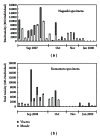Tetrodotoxin poisoning due to pufferfish and gastropods, and their intoxication mechanism
- PMID: 23724281
- PMCID: PMC3658506
- DOI: 10.5402/2011/276939
Tetrodotoxin poisoning due to pufferfish and gastropods, and their intoxication mechanism
Abstract
Marine pufferfish generally contain a large amount of tetrodotoxin (TTX) in their skin and viscera, and have caused many incidences of food poisoning, especially in Japan. Edible species and body tissues of pufferfish, as well as their allowable fishing areas, are therefore clearly stipulated in Japan, but still 2 to 3 people die every year due to pufferfish poisoning. TTX is originally produced by marine bacteria, and pufferfish are intoxicated through the food chain that starts with the bacteria. Pufferfish become nontoxic when fed TTX-free diets in a closed environment in which there is no possible invasion of TTX-bearing organisms. On the other hand, TTX poisoning due to marine snails has recently spread through Japan, China, Taiwan, and Europe. In addition, TTX poisoning of dogs due to the ingestion of sea slugs was recently reported in New Zealand. TTX in these gastropods also seems to be exogenous; carnivorous large snails are intoxicated by eating toxic starfish, and necrophagous small-to-medium snails, the viscera of dead pufferfish after spawning. Close attention must be paid to the geographic expansion and/or diversification of TTX-bearing organisms, and to the sudden occurrence of other forms of TTX poisoning due to their ingestion.
Figures




References
-
- Yotsu-Yamashita M. Chemistry of puffer fish toxin. Journal of Toxicology—Toxin Reviews. 2001;20(1):51–66.
-
- Narahashi T. Pharmacology of tetrodotoxin. Journal of Toxicology—Toxin Reviews. 2001;20(1):67–84.
-
- Hwang DF, Noguchi T. Tetrodotoxin poisoning. Advances in Food and Nutrition Research. 2007;52:141–236. - PubMed
-
- Mosher HS, Fuhrman FA, Buchwald HD, Fischer HG. Tarichatoxin—tetrodotoxin: a potent neurotoxin. Science. 1964;144(3622):1100–1110. - PubMed
-
- Miyazawa K, Noguchi T. Distribution and origin of tetrodotoxin. Journal of Toxicology—Toxin Reviews. 2001;20(1):11–33.
LinkOut - more resources
Full Text Sources
Miscellaneous

